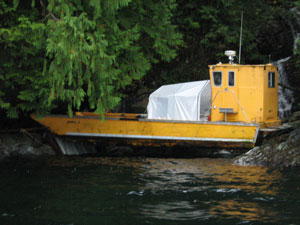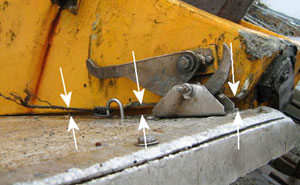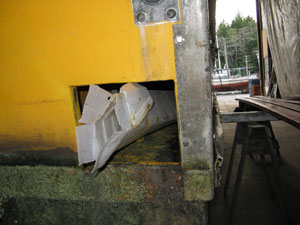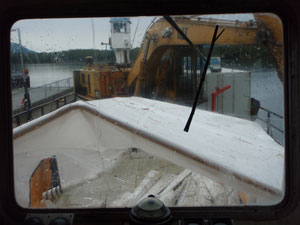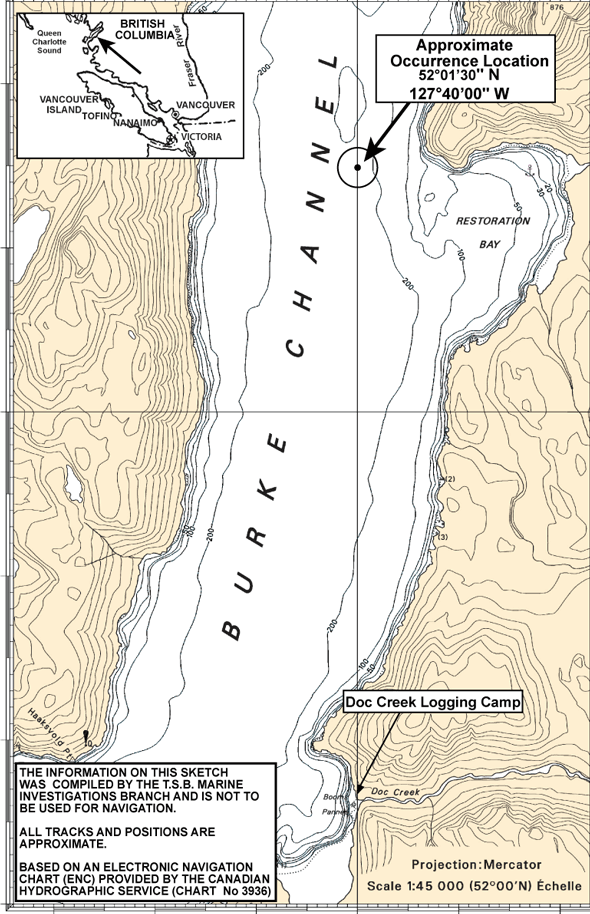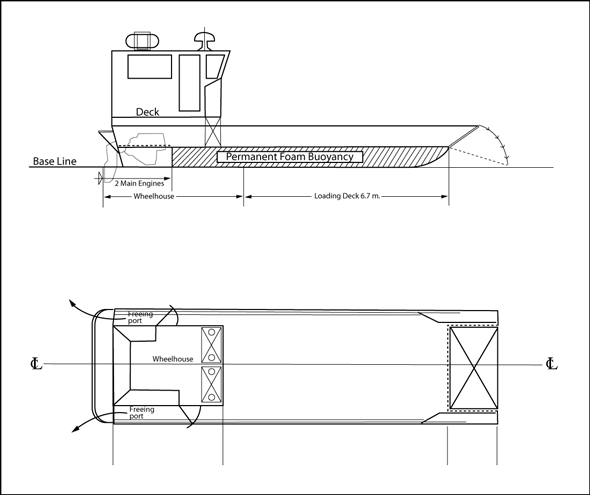Near capsizing with loss of life
SeaLander 37 landing craft Jumbo B
Burke Channel, Restoration Bay, British Columbia
The Transportation Safety Board of Canada (TSB) investigated this occurrence for the purpose of advancing transportation safety. It is not the function of the Board to assign fault or determine civil or criminal liability. This report is not created for use in the context of legal, disciplinary or other proceedings. See Ownership and use of content. Masculine pronouns and position titles may be used to signify all genders to comply with the Canadian Transportation Accident Investigation and Safety Board Act (S.C. 1989, c. 3).
Summary
On the morning of 30 October 2008, the landing craft Jumbo B, with an operator and six passengers on board, was bound for King Island, British Columbia. At about 0900 Pacific daylight time while underway, the bow ramp opened and water was shipped through the opening, causing a starboard list. The operator and two of the passengers jumped overboard. The remaining four passengers subsequently beached the vessel. Of the three persons who entered the water, one re-boarded the vessel, the body of a second was recovered afterward, and one is still missing.
Factual information
Particulars of the vessel
| Name of vessel | Jumbo B |
|---|---|
| Official Number | 395574 |
| Port of Registry | Vancouver (B.C.) |
| Flag | Canada |
| Type | General cargo |
| Gross tonnageFootnote 1 | 7.97 |
| Length | 11.28 m |
| Built | 1980 |
| Propulsion |
2 x 200 kW Volvo Penta diesel twin propellers |
| Cargo | 1250 kg of tree cones |
| Passengers | 6 |
| Crew | 1 |
| Registered Owner(s) | Kitimat Command Marine Supply, Ltd. |
| Manager(s) | Kirk Ventures, Ltd. |
Description of the vessel
The Jumbo B is a single-deck, shallow draft landing craft. The engines are located aft and are controlled from the wheelhouse.
The hull is of a box-frame construction. It is fitted with polyurethane foam beams overlaid with heavy duty fibreglass for positive buoyancy. There is no bilge (see Appendix B for general arrangement of vessel).
The vessel is designed to have positive buoyancy with the bow door down and the aft freeing ports open. When underway, the bow door is to be closed to prevent water from entering and accumulating on deck. The aft freeing ports are intended to shed any water that may be shipped over the bow door or gunwales.
The vessel originally had twin gasoline engines. In 1995, these were replaced with heavier marine diesel engines. In 2007, the operator modified the bow ramp, replacing the single-winch arrangement with two winches.
A temporary canopy had been erected on deck immediately forward of the wheelhouse as a shelter for passengers on the well deck. The canopy restricted the view of the bow ramp from the wheelhouse.
History of the voyage
The Jumbo B was chartered to Brinkman and Associates, a re-forestry company, to carry plastic tree cones from various tree lots.Footnote 2
On 29 October 2008 at 1830,Footnote 3 the Jumbo B returned to Doc Creek logging camp after working at a site on King Island, B.C., carrying approximately 1250 kg of tree cones.Footnote 4 The cones were loaded on deck in a fore and aft direction.
At 0800 the next morning, the six passengers boarded the vessel for transport to King Island, which was approximately six nautical miles away. At 0830, with the passengers and the operator in the wheelhouse, the Jumbo B departed Doc Creek with the previous day's tree cones still on deck. At approximately 0900, the vessel cleared the headland north of Restoration Bay and entered Burke Channel. Northerly winds were estimated at 20 knots with seas of 1 to 1.5 m in height. At this time, several loud bangs were heard from the forward end, and water was observed on deck. The vessel took on a starboard list and the plastic cones shifted to starboard.
The passengers were told by the operator to don lifejackets. The operator and two of the six passengers grabbed, but did not don, personal flotation devices (PFDs) before exiting the wheelhouse via the starboard door. The operator and one passenger who had grabbed a PFD jumped off the starboard side. A second passenger also entered the water with a PFD and held onto the vessel's starboard bulwark.
While in the water, the operator yelled to those on board to steer the vessel. Two of the remaining four passengers took the wheel and pulled back on the throttles, at which point the vessel slowly started to right itself. Water had by then entered the engine space through the starboard vent, whereupon the starboard engine stopped and power steering was lost.
To reduce the weight on deck, and because the cones were partially obstructing the freeing ports and preventing water from draining off the deck, three of the passengers began throwing cones overboard. They were assisted by the passenger holding onto the side of the vessel.
As the vessel continued to come upright, the passenger at the wheel was able to steer,Footnote 5 and the passenger hanging onto the starboard bulwark re-boarded the vessel on his own.
The two persons remaining in the water were no longer visible; nonetheless, those on board conducted a brief search. Then, concerned that the vessel would capsize, they steered the vessel to the shore and disembarked.
Search and rescue
While en route to shore, the passengers attempted to dial 911 on the satellite phone, but were unsuccessful. Using an onboard directory of satellite telephone numbers, they contacted the B.C. Timber Service at 0910. Their contact called 911, who in turn contacted the Joint Rescue Coordination Centre (JRCC), Victoria, B.C., which then initiated the search-and-rescue effort. There was a marine VHF radiotelephone on board, but it was not turned on.
At 0913, the Canadian Coast Guard (CCG) fast rescue craft BB1 and the CCG Cutter Cape Farewell were tasked from the CCG base at Bella Bella, B.C. At 0924, a Buffalo 452 and Cormorant 906 from the Canadian Forces base at Comox, B.C., were tasked and departed at 0946 to assist in the search. Two private helicopters also assisted in the search, departing from Doc Creek and Bella Coola at 0929 and 0950, respectively.
At 1021, BB1 recovered the body of the operator, who was not wearing a lifejacket or PFD. At 1137, the Cape Farewell was on scene with the Jumbo B and the five surviving passengers on shore in position 52°03.275′ N, 127°38.69′ W. A search for the remaining passenger continued until 1841, at which time it was turned over to the Royal Canadian Mounted Police as a missing person case.
Injuries to persons
The operator died, and a passenger is missing.
The remaining passengers were taken to Port Hardy for medical evaluation and released that evening.
Vessel registration
The vessel had been sold to Kirk Ventures, Ltd. in February 2003, but remained registered with Kitimat Command Marine Supply, Ltd.
Vessel certification
The vessel was registered as a general cargo vessel. As a general cargo vessel less than 15 tons, it was not subject to annual inspection from Transport Canada (TC), nor is there a record that it ever received one. The vessel had not been inspected or certified to carry passengers, nor was it required to be under the Vessel Certificates Regulations.Footnote 6
However, the Hull Inspection Regulations state that, in order to carry passengers, the vessel would require an annual inspection of its structural condition. The condition of the firefighting, lifesaving, navigation, and communication equipment would also be subject to annual inspection. Such an inspection would also include verification of crew competency certificates and any licences required to be carried on board. Crew members could also be required to demonstrate an emergency drill.
In addition, TC's inspection regime for small commercial vessels, the Small Vessel Monitoring and Inspection Program, is intended to enhance the safety of small commercial and passenger vessels that are not more than 15 gross tons and carry no more than 12 passengers.Footnote 7
The inspection by TC verifies that the vessel and crew meet the safety requirements for:
- construction of hull and machinery;
- stability;
- lifesaving, navigation, and communication equipment; and
- training and certification of crew members.
It is the responsibility of the owner to contact the nearest TC Centre to arrange this inspection. Subsequently, it is the responsibility of the owner or operator to conduct an annual self-inspection. A self-inspection checklist is available from TC. The system is reinforced by spot checks.
There are no records to indicate that the Jumbo B, its owner, or operator had participated in the Small Vessel Monitoring and Inspection Program at any time.
Personnel certification and experience
The operator had operated the Jumbo B since February 2003.
The operator had previously worked on other vessels and held a Small Vessel Operator Proficiency (SVOP) training certificate issued on 26 November 2002. The operator also held a Marine Emergency Duties (MED) A3 certificate, as required for a small non-passenger-carrying vessel not exceeding 15 gross tonnage, and a Radio Operator Certificate - Marine.
When operating as a passenger or a cargo vessel above 5 gross tonnage, however, an operator is required to hold a Master, Limited certificate (for a vessel of less than 60 gross tonnage) valid for both the vessel and the geographic area of operation, an MED A2, and must hold a valid medical certificate. Also, a person on board is required to hold a Restricted Small Vessel Machinery Operator certificate of competence.
Crewing level
The Marine Personnel Regulations, Part 2, Crewing, set out a vessel's minimum deck watch and crew needed for carrying out tasks including assisting during an emergency.Footnote 8 These regulations stipulate that, for a vessel carrying passengers, another crew member shall be on board to assist the operator.
Vessel construction and modifications
Bow ramp, winches, pulleys, and wires
The bow ramp is hinged along the bottom edge (see Photo 2). The two winches, each with a capacity of 682 kg, were installed on either side of the vessel in 2007. They are used in conjunction with wires and steel pulleys to open and close the bow ramp, but are not designed to hold the door shut.
Each wire is 5 mm of 7 x 19 of galvanized carbon steel with a breaking strength of 1987 kg. The TSB LaboratoryFootnote 9 analysis found that both wires had parted where they passed over the pulleysFootnote 10 and that the region around the fractured wires was visibly corroded.
The port pulley was corroded and did not rotate freely. The pulley had a diameter of 5 cm, approximately 13 times the diameter of the 5 mm wire. The pulley-to-cable ratio recommended in most literature is at least 30:1.Footnote 11
Bow ramp latch
A latch on each side of the vessel was designed to keep the bow ramp secured when closed. Both latches were worn, the bearing surface of the latch hook having been polished smooth by wear. The hinge pin of the latch hook also had considerable freeplay within the bushing.
The pin, against which the latch engages to complete the locking process, is mounted within a bracket on the bow door. This bracket's holes were found ovalized by wear. The latch design does not include any locking mechanism to keep the latch handle in the closed position.
Rubber gasket
When the bow ramp was closed, a rubber gasket ensured a watertight seal between the bow ramp and the vessel's hull. Post-occurrence examination revealed that large sections of this gasket were missing. A gap therefore existed between the bow ramp and the hull, even with the ramp closed and the latches engaged.
Freeing ports
The vessel was originally fitted with two hinged freeing ports on either side of the transom. Examination revealed that the cover of the starboard freeing port was missing.
The vessel was normally trimmed by the stern to the extent that the waterline was approximately 50 mm above the lower edge of the freeing ports and the main deck. Algae and marine growth were noted above the lower edge of the freeing ports and onto the after part of the main deck (see Photo 4).
Lifesaving and distress equipment, and safety briefings
A post-occurrence inspectionFootnote 12 of the lifesaving equipment revealed the following:
- one lifejacket was left on boardFootnote 13; it lacked the required reflective tape, was soiled, and was in poor condition;
- four Type B pyrotechnic distress signals (these had expired as of September 2003);
- two Class B 2 ½ pound fire extinguishers (corrosion had rendered the expiry dates illegible);
- no lifebuoy or buoyant heaving line was found, although the vessel was fitted with a support bracket for a lifebuoy; and
- no liferaft was aboard.
For a vessel that transports passengers, a briefing is to be given prior to departure regarding the vessel's safety and emergency procedures. In this occurrence, no pre-departure safety briefing was given. The passengers were not made aware of the safety procedures, nor were they informed of the lifesaving equipment on board.
The minimum lifesaving and distress equipment for cargo vessels such as the Jumbo B and for vessels carrying passengers are contained in the Small Vessel Regulations. Both types of vessels require the carriage of a properly sized approved standard lifejacket or small vessel lifejacket for each person on board (in this case, seven), as well as other equipment such as an approved lifebuoy, approved pyrotechnic distress signals (in this case, six), and one fire extinguisher.
As a cargo vessel, the Jumbo B did not carry a liferaft. As a passenger-carrying vessel, and given the area of occurrence and time of year,Footnote 14 it was required to carry one.
Weather
The CCG Cutter Cape Farewell, which arrived within two hours of the occurrence, reported on-scene weather as: showers, northeast winds at 20 knots, and waves 1.5 m in height.
Small commercial vessel fleet
In Canada, a small commercial vessel under 15 gross tonnage must be licensed or registered. All vessels over 15 gross tonnage must be registered.
In 2005, TC estimated that approximately 50 000 small commercial vessels (non-fishing) were operating in Canada.Footnote 15 As of April 2009, TC indicated that 32 353 of these were licensed or registered (15 gross tonnage or less)-including the Jumbo B.
The difference between these figures (about 17 500) provides an estimate of the number of small commercial vessels that are not captured by either the licensing or registration systems.
With respect to the Small Vessel Monitoring and Inspection Program, TC has taken steps to identify the small vessel population. For example, in the Pacific Region, TC has created an office of primary interest in Kelowna, B.C., and is in the process of identifying, collating and contacting all registered small commercial vessel operators in B.C. Currently, a list of some 12 500 vessels has been created.
Prior occurrences
TSB statistics indicate that between 1998 and 2008 there were 1023 occurrences involving small commercial vessels under 15 gross tonnage, including 49 fatalities.
On 03 December 2001, a workboat carrying five construction workers on Lake des Deux Montagnes, Quebec, was swamped and sank, causing three fatalities.Footnote 16 The vessel had not been identified by TC or inspected as a commercial vessel, nor had the owner requested an inspection. An investigation by the Commission de la santé et de la sécurité au travailFootnote 17 revealed that the workboat lacked reserve buoyancy, the available rescue boat was not suitably equipped, the cold water conditions contributed to the fatalities, and the passengers were not wearing lifejackets.
On 15 May 2002, the workboat 36E33460 was being used to transport a roofing crew of four and a cargo of used shingles from a construction site on Anstruther Lake, Ontario.Footnote 18 In mid-lake, the deeply laden vessel began taking water over the bow. Shortly thereafter, the vessel swamped and sank. The four roofers swam to shore and the operator drowned. The investigation revealed that TC was unaware that the vessel was operating as a small passenger vessel, that neither federal nor Ontario provincial regulations have provisions to protect workers against hypothermia while travelling as passengers on small commercial vessels, and that in the absence of effective federal and provincial regulatory requirements, workers being carried as passengers on small commercial vessels may be put at risk.
On 10 December 2003, while departing from a work site on Payette Island, Georgian Bay, Ontario, a workboat with four persons aboard capsized.Footnote 19 Three persons were rescued and one person drowned. The investigation revealed that TC had not identified the workboat as a small commercial vessel and that the past system of licensing vessels was not conducive to readily identifying vessels engaged in commercial operation. Although the vessel had been modified, the owner had not contacted TC for a post-modification inspection, nor was he aware of the need to do so.
Analysis
Bow ramp failure
In a landing craft of this type, the bow ramp's watertight integrity depends on its design and the condition of all components. This includes ensuring that elements of the system are of the correct size and quality/condition, that they are of compatible material, and that they are repaired or replaced when missing, damaged, or defective. It would also include making sure that all components perform their assigned function and that backups are in place where possible.
In this occurrence, although the winching system and its components had been modified only the previous year, the port pulley was corroded such that it did not rotate freely. The wire was also corroded where it passed over the pulley. Sections of the rubber gasket that sealed the bow ramp door to the landing craft were also missing, and the holes in the latch bracket were found ovalized, indicating that the bracket had been subject to strain.
Additionally, the ramp's design was such that there was no locking mechanism to keep the latch closed once the ramp was up; instead, this was accomplished by maintaining continuous tension on the winch wire. This wire, which had originally been intended only to raise and lower the ramp, was further subjected to a cyclical loading component from wave action pushing against the door.
The wire was weakened by a combination of fatigue, corrosion, and the abrasion from being in constant stress against the incorrectly sized pulley.Footnote 20 The resulting localized weak pointFootnote 21 fractured. The other wire then failed, leaving the ramp held closed only by the two non-locking latches. However, because the absence of portions of the watertight gasket meant the latches contained a great deal of freeplay, these were able to work their way open. This allowed the ramp to fall completely open and permitted water to flood the well deck.
It is also possible, however, that the latches failed prior to the wire parting.
Because of the poor condition of the bow ramp latches and the lack of a locking mechanism, tension was being maintained on the lifting wires to keep the ramp closed. The winch system had been inappropriately modified and parts of it, including the wires, were badly corroded. One wire failed due to fatigue where it passed over an incorrectly sized pulley, causing the other wire to take the full weight of the bow ramp and to fail similarly.
Once the bow ramp opened, water was shipped aboard. The blocked freeing ports restricted the vessel's ability to shed this water, and the accumulated weight caused a starboard list until the vessel slowed down, water was shed, and it righted itself.
Obstructed bow view
From the landing craft's wheelhouse, the operator was in the best position to view the vessel's well deck and perform lookout duties.
However, the canopy restricted the view forward. As a result, when the operator and the passengers inside the wheelhouse heard the banging from forward and observed water on deck, they were unable to determine the immediate cause-that the bow ramp door had failed.
Vessel operation and inspections
All passengers on commercial vessels, whether tourists or silviculture workers, have an expectation that vessels are safe, the operators competent, and that they will not be put at undue risk by the voyage. To this end, TC provides operators with a national regulatory system that applies to the structural and operational safety of vessels. It is up to owners/operators to identify their intended operation and, once this has been done, the assessments of a vessel's condition and the competence of its operators falls under the jurisdiction of TC. Owners/operators must then ensure that their vessels are appropriately crewed, equipped, and operated in accordance with their intended purpose as registered.
What is appropriate for a cargo vessel, however, differs from what is required of a passenger vessel. In this occurrence, although the master had five years of experience with the Jumbo B and held a Small Vessel Operator Proficiency training certificate, he was not certified to operate the vessel as a passenger-carrying or cargo vessel. As such, there was no verification that he possessed the requisite knowledge or skill, or that he was prepared for vessel operations. Moreover, because the Jumbo B was registered as a cargo vessel and because it had a gross tonnage not exceeding 15 tons, it was not subject to annual inspection from TC. Neither had the operator opted to take part in the Small Vessel Monitoring and Inspection Program. The resulting absence of any inspection/verification of the Jumbo B's condition deprived the operator of an opportunity to address safety deficiencies that may have been uncovered. For instance, firefighting/lifesaving equipment was in poor condition, out of date, or missing. Also, the condition of the bow door and its securing system was poor.
The use of small commercial vessels to carry passengers is common in Canada. Although the Jumbo B was used to ferry silviculture workers on a regular basis, it had not been identified or classified as a passenger-carrying vessel to TC. It thus did not receive the required annual inspection, and the required safety briefing was not given to the workers prior to departure.
Therefore, vessels that have not been identified and inspected for their intended use may not have the appropriate equipment on board. Moreover, operators who lack proper certification may be unaware of safety and equipment requirements and thus may be inadequately prepared for vessel operations.
Crewing level
It is important to passenger and vessel safety that a vessel's crewing level is sufficient to deal with all situations. This includes having the appropriate number of crew members to carry out regular duties as well as to assist the master when required, particularly in the event of any emergency.
The operator was solely responsible for the deck watch. In this occurrence, however, the vessel was operating as a passenger vessel but without the required additional crew member. Therefore, there was no additional crew member available and trained in emergency and survival procedures, including assisting passengers with the donning of lifejackets and PFDs.Footnote 22
This lack of sufficient crew to perform all necessary tasks-particularly during an emergency-puts passengers, the crew, and the vessel at undue risk.
Findings
Findings as to causes and contributing factors
- Due to the poor condition of the bow ramp latches, the missing sections of rubber gasket, and the lack of a locking mechanism, tension was being maintained on the lifting wires to keep the ramp closed.
- The winch system had been inappropriately modified and parts of it, including the wires, were badly corroded. One wire failed in fatigue where it passed over an incorrectly sized pulley, causing the other wire to take the full weight of the bow ramp and to fail similarly.
- The canopy restricted the view forward and prevented the operator from determining that the bow ramp door had failed.
- The plastic tree cones shifted to partially obstruct the freeing ports and prevented the water from draining from the well deck.
- The water on deck and resulting list prompted three persons to abandon the vessel.
Findings as to risk
- Operators who lack proper certification may be unaware of safety and equipment requirements and inadequately prepared for vessel operations.
- Small commercial vessels that have been registered as cargo vessels but are used to carry passengers may not have the appropriate equipment on board.
- A lack of sufficient crew members to perform all necessary tasks-particularly during an emergency-puts the passengers, the crew, and the vessel at undue risk.
- Where small commercial vessel operators do not conduct (or delegate) regular inspections, safety deficiencies may persist.
Safety action
Action taken
On 09 December 2008, the TSB sent Marine Safety Advisory (MSA) 11/08 to Brinkman and Associates, the company that contracted the Jumbo B, with a copy sent to Transport Canada (TC), regarding the safety of employees being transported. The MSA advised that vessels be appropriately registered, maintained, and equipped, and that operators/crew be adequately trained and certified.
In March 2009, TC informed the TSB that, at the December 2008 National Tonnage Committee meeting, TC agreed to expand the existing list of vessel types and to examine how it can identify vessels that have dual operation on the Canadian Register of Vessels and Certificate of Registry. This was done in an effort to capture those small commercial vessels that may also occasionally carry passengers but are not certified to do so.
TC is currently updating the Small Commercial Vessel Safety Guide.
This report concludes the Transportation Safety Board's investigation into this occurrence. Consequently, the Board authorized the release of this report on .
